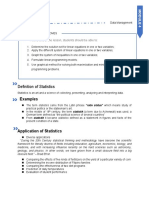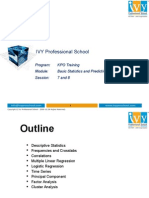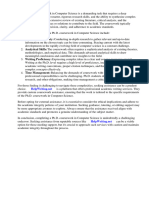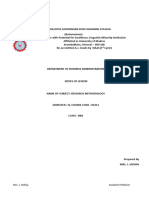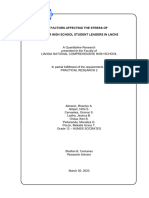Workshop: R For Statistical Analysis
Uploaded by
Omeet HannahWorkshop: R For Statistical Analysis
Uploaded by
Omeet Hannah7/13/2020 R for Statistical Analysis
Workshop: R for Statistical Analysis
Data Analysis Team:
Matty Jullamon (GAA)
Amir Michalovich (GAA)
Jeremy Buhler (Data Librarian)
Sarah Parker (Data Librarian)
Pre-workshop setup
Download and install R
For Windows:
1. Visit R Project (https://www.r-project.org/) to learn about R versions.
2. Download and install R from your preferred CRAN mirror here (https://cran.r-project.org/mirrors.html)
A. Choose "0-Cloud" or a mirror site near you.
For Mac:
1. Check that your macOS system is up-to-date
2. Download and install R from The Comprehensive R Archive Network (https://cran.r-project.org/)
Download and install R studio
For Windows and Mac:
1. Download and install R Studio from here (https://rstudio.com/products/rstudio/download/#download)
https://ubc.syzygy.ca/jupyter/user/mj2653/nbconvert/html/R for Statistical Analysis.ipynb?download=false 1/16
7/13/2020 R for Statistical Analysis
Learning Objectives
Learn how to identify the types of variables in R
Learn the basic commands for descriptive statistics
Learn the basic commands for inference statistics
Overview of Quantative Research Process
A systamatic research process that involves collecting objective, measureable data, using statistics to analyze
the data, and generalizing the results to a larger population to explain a phenomena. Usually, software programs
assist on data analysis.
Data Analysis in Quantitative Research
Definitions
Data refers to facts or pieces of information that can either be quantitative or qualitative.
Variable refers to any property that can be observed or measured.
https://ubc.syzygy.ca/jupyter/user/mj2653/nbconvert/html/R for Statistical Analysis.ipynb?download=false 2/16
7/13/2020 R for Statistical Analysis
Types of Variables
It is important to understand the different types of variables because they will determine the statistical analysis
method.
Type Description Example
Nominal 名义上的 Labels or Descriptions that cannot be ordered Gender
Ordinal Labels or Descriptions that can be ordered Education Level
Interval Numeric values with equal magnitude, doesn't have absolute zero SAT scores
Ratio Numeric values with equal magnitude, does have absolute zero Age
Categorize these variables in R
Nominal/Ordinal -> Character or Factor
Intervel/Ratio -> Numeric or Integer
Definitions
Character: Text
Factor: Integer associated with a specific category
Numeric: Number with decimal point
Integer: Number with no decimal point
Getting Started
Set working directory in R studio
You can set the working directory using Session > Set Working Directory > Choose Directory.
Loading a built-in R dataset
https://ubc.syzygy.ca/jupyter/user/mj2653/nbconvert/html/R for Statistical Analysis.ipynb?download=false 3/16
7/13/2020 R for Statistical Analysis
About the data
3 Measures Of Ability: SATV, SATQ, ACT: "Self reported scores on the SAT Verbal, SAT Quantitative and ACT
were collected as part of the Synthetic Aperture Personality Assessment (SAPA) web based personality
assessment project. Age, gender, and education are also reported. The data from 700 subjects are included here
as a demonstration set for correlation and analysis" (Revelle et al., 2009).
(https://www.rdocumentation.org/packages/psych/versions/1.9.12.31/topics/sat.act)
Write and run the following commands to load the dataset
install.packages("psych") #install this if you haven't done so.
library(psych)
scores <- sat.act
https://ubc.syzygy.ca/jupyter/user/mj2653/nbconvert/html/R for Statistical Analysis.ipynb?download=false 4/16
7/13/2020 R for Statistical Analysis
In [ ]: scores <-read.csv("sat.act.csv")
Identifying and Renaming Variables
str(df ): To check the structure of your data
Question: What do you notice?
as.factor(df$columnname): To change a variable to factor
In [64]: scores$gender <- as.factor(scores$gender)
is.factor(df$columnname): To check if a variable is defined as factor
In [62]: is.factor(scores$gender)
TRUE
Extra information
is.integer(df$columnname): To check if a variable is defined as integer
is.numeric(df$columnname): To check if a variable is defined as numeric
is.character(df$columnname): To check if a varible is defined as character
as.integer(df$columnname): To change a variable to integer
as.numeric(df$columnname): To change a variable to numeric
as.character($columnndfame): To change a variable to character
https://ubc.syzygy.ca/jupyter/user/mj2653/nbconvert/html/R for Statistical Analysis.ipynb?download=false 5/16
7/13/2020 R for Statistical Analysis
Exercise #1
Using as.factor command, change 'education' to factor.
Using is.factor command, check if 'education is defined as factor.
Answer to Exercise #1
In [75]: scores$education <- as.factor(scores$education)
In [76]: is.factor(scores$education)
TRUE
Descriptive Statistics
Descriptive statistics summarize the data in a meaningful way. The purpose of using descriptive statistics is to
explore the observed data and not to draw inferences.
We will use the psych package functions to perform descriptive statistics.
describe(df): To obtain descriptive statistics for all variables
hist(df$columnname): To graphically descibe the distribution using histogram
https://ubc.syzygy.ca/jupyter/user/mj2653/nbconvert/html/R for Statistical Analysis.ipynb?download=false 6/16
7/13/2020 R for Statistical Analysis
In [78]: hist(scores$SATV)
https://ubc.syzygy.ca/jupyter/user/mj2653/nbconvert/html/R for Statistical Analysis.ipynb?download=false 7/16
7/13/2020 R for Statistical Analysis
In [95]: # To add the distribution curve
hist(scores$SATV, freq = F)
x <- 200:800
y <- dnorm(x = x, mean = 612.23, sd = 112.90)
lines(x = x, y = y)
Inferential Statistics
Unlike descriptive statistics, inferential statistics use the observed data to make inferences about the population.
In this workshop, we will cover four parametric tests: Independent t-test, One-way ANOVA, Pearson's correlation,
& Simple linear regression. These tests are called parametric because they meet the assumptions of probability
distribution.
https://ubc.syzygy.ca/jupyter/user/mj2653/nbconvert/html/R for Statistical Analysis.ipynb?download=false 8/16
7/13/2020 R for Statistical Analysis
Model assumptions
Common model assumptions found in parametric tests:
1. Independence
2. Normality
3. Equal variance
Both Pearson's correlation and Simple linear regression have some additional assumptions. For more
information, click on the following links:
Pearson's correlation assumptions (https://www.statisticssolutions.com/correlation-pearson-kendall-spearman/)
Simple linear regression assumptions (https://www.statisticssolutions.com/assumptions-of-linear-regression/)
Independent T-test
It is used to see whether there are group difference in numeric data between two groups.
For example, do males and females have different average SAT verbal scores?
H0: Mean SATV for males = Mean SATV for females
H1: Mean SATV for males != Mean SATV for females
In [ ]: #Write and run this command:
t.test(scores$SATV ~ scores$gender, data = scores, var.eq = TRUE)
https://ubc.syzygy.ca/jupyter/user/mj2653/nbconvert/html/R for Statistical Analysis.ipynb?download=false 9/16
7/13/2020 R for Statistical Analysis
Interpreting the results
t: computing statistics
df: degrees of freedom
p-value: Statistical significance. 0.6187 is bigger than α = 0.05 so that means we must retain the null
hypothesis
Conclusion
There was no statistically significant difference in SAT verbal scores between males and females, t(698) = 0.50,
p = 0.62.
One-way ANOVA
It is used to determine whether there are group differences in numeric data between more than two groups
For example, do SAT verbal scores significantly differ by educational levels (1= HS, 2= some college degree, 3 =
2-year college degree, 4= 4-year college degree, 5= graduate work)?
H0: Mean SATV of students who have HS degree = Mean SATV of students who have some college degree = ...
H1: Mean SATV of students who have HS degree != Mean SATV of students who have some college degree !=
...
In [ ]: #Write and run this command:
m1 <- aov(scores$SATV ~ scores$education, data = scores)
summary(m1)
https://ubc.syzygy.ca/jupyter/user/mj2653/nbconvert/html/R for Statistical Analysis.ipynb?download=false 10/16
7/13/2020 R for Statistical Analysis
Interpreting the results
df: degree of freedom
sum sq: sum of squares
mean sq: mean squares
F value: computing statistics
Pr(>F): statistical significance. 0.275 is bigger than α = 0.05 so that means we must retain the null
hypothesis. We do not have to run the post hoc tests because the group differences are not significant.
Does this make sense?
Check using boxplot.
In [ ]: # Write and run this command:
boxplot(scores$SATV ~ scores$education)
https://ubc.syzygy.ca/jupyter/user/mj2653/nbconvert/html/R for Statistical Analysis.ipynb?download=false 11/16
7/13/2020 R for Statistical Analysis
Conclusion
There were no significant group differences in SAT verbal scores according to students' educational levels, F(5,
694) = 1.269, p = 0.275.
Extra information
There are different types of post hoc tests
(https://www.rdocumentation.org/packages/DescTools/versions/0.99.36/topics/PostHocTest), but the Tukey's
HSD is the most popular post hoc test for comparing multiple pairings.
In [2]: # R command for Tukey's HSD:
# TukeyHSD(aov(scores$SATV ~ scores$education, data = scores), conf.level=.95)
Pearson's Correlation
It is used to examine relationships between variables (represented by numeric data)
For example, Is there a relationship between SATV and SATQ?
H0: There is no relationship between SATV and SATQ.
H1: There is a relationship between SATV and SATQ.
In [ ]: # Write and run this command:
cor.test(scores$SATV,scores$SATQ)
https://ubc.syzygy.ca/jupyter/user/mj2653/nbconvert/html/R for Statistical Analysis.ipynb?download=false 12/16
7/13/2020 R for Statistical Analysis
In [ ]: # Write and run this command to see scatterplot:
plot(scores$SATV,scores$SATQ)
abline(lm(scores$SATQ ~ scores$SATV)) #to add regression line
Conclusion
There was statistically significant positive correlation between SAT verbal scores and SAT Quantitative scores (r
= 0.644, p < 0.001).
Simple Linear Regression (for your reference)
It is used to explain/predict the phenomenon of interest based one independent variable.
For example, do ACT scores predict SAT verbal scores?
In [ ]: # Write and run this command:
m2 <- lm(scores$SATV ~ scores$ACT)
summary(m2)
https://ubc.syzygy.ca/jupyter/user/mj2653/nbconvert/html/R for Statistical Analysis.ipynb?download=false 13/16
7/13/2020 R for Statistical Analysis
Interpreting the results
The estimated regression line equation: SATV = 237.34 + 13.13(ACT scores)
31% of the variability in the SAT verbal scores was explained by the variables in the regression model.
The overall regression model significantly explained the SAT verbal scores.
Conclusion
ACT scores significantly predicted SAT verbal scores. We would expect 13.13 points increase in SAT verbal
scores for every one point increase in ACT score, assuming all the other variables are held constant.
https://ubc.syzygy.ca/jupyter/user/mj2653/nbconvert/html/R for Statistical Analysis.ipynb?download=false 14/16
7/13/2020 R for Statistical Analysis
Questions?
https://ubc.syzygy.ca/jupyter/user/mj2653/nbconvert/html/R for Statistical Analysis.ipynb?download=false 15/16
7/13/2020 R for Statistical Analysis
Reference(s);
Revelle, William, Wilt, Joshua, and Rosenthal, Allen. (2009). Personality and Cognition: The Personality-
Cognition Link. In Gruszka, Alexandra and Matthews, Gerald and Szymura, Blazej (Eds.) Handbook of Individual
Differences in Cognition: Attention, Memory and Executive Control, Springer.
https://ubc.syzygy.ca/jupyter/user/mj2653/nbconvert/html/R for Statistical Analysis.ipynb?download=false 16/16
You might also like
- [Ebooks PDF] download Statistics Using Stata An Integrative Approach Sharon Lawner Weinberg full chapters100% (1)[Ebooks PDF] download Statistics Using Stata An Integrative Approach Sharon Lawner Weinberg full chapters55 pages
- Statistical Analysis Using SPSS and R - Chapter 1 To 3 PDF100% (1)Statistical Analysis Using SPSS and R - Chapter 1 To 3 PDF132 pages
- A Quick and Easy Guide in Using SPSS for Linear Regression AnalysisFrom EverandA Quick and Easy Guide in Using SPSS for Linear Regression AnalysisNo ratings yet
- DATA PROCESSING, ANALYSING AND INTERPRETATION Ipmi100% (1)DATA PROCESSING, ANALYSING AND INTERPRETATION Ipmi120 pages
- SPSS Workshop: Utilizing and Implementing SPSS in Our OC-Math Statistics ClassesNo ratings yetSPSS Workshop: Utilizing and Implementing SPSS in Our OC-Math Statistics Classes11 pages
- Sana H - Data Analysis in Psychological ResearchNo ratings yetSana H - Data Analysis in Psychological Research5 pages
- PSY - 2060 - 2022H1 - Session 01 2022-01-19 02 - 39 - 01No ratings yetPSY - 2060 - 2022H1 - Session 01 2022-01-19 02 - 39 - 0124 pages
- Introduction To Business Statistics Through R Software: SoftwareFrom EverandIntroduction To Business Statistics Through R Software: SoftwareNo ratings yet
- Module I. Basic Calculations. Average, Standard Deviation by Excel (5)No ratings yetModule I. Basic Calculations. Average, Standard Deviation by Excel (5)48 pages
- Statistics Using r - Sharon Lawner Weinberg, Daphna Harel - CopyNo ratings yetStatistics Using r - Sharon Lawner Weinberg, Daphna Harel - Copy726 pages
- Intro To Traditional and Bayesian M Using R-Guilford 2017No ratings yetIntro To Traditional and Bayesian M Using R-Guilford 2017330 pages
- Data analysis training workshop_Day 2 presentationNo ratings yetData analysis training workshop_Day 2 presentation52 pages
- Section 6 Data - Statistics For Quantitative StudyNo ratings yetSection 6 Data - Statistics For Quantitative Study142 pages
- Module 1: Unit - 1.1: Introduction To Analytics or R ProgrammingNo ratings yetModule 1: Unit - 1.1: Introduction To Analytics or R Programming26 pages
- Lesson One Introduction To Inferential StatisticsNo ratings yetLesson One Introduction To Inferential Statistics20 pages
- An Introduction To Statistical AnalysisNo ratings yetAn Introduction To Statistical Analysis20 pages
- Main Title: Planning Data Analysis Using Statistical Data100% (1)Main Title: Planning Data Analysis Using Statistical Data40 pages
- Unit-4 Big Data Analytics Methods using RNo ratings yetUnit-4 Big Data Analytics Methods using R57 pages
- Statistical Instruments and References Writing in ResearchNo ratings yetStatistical Instruments and References Writing in Research36 pages
- Chap13 Quantitative Data Analysis Revised Jan2021No ratings yetChap13 Quantitative Data Analysis Revised Jan202154 pages
- Module - 4 (R Training) - Basic Stats & ModelingNo ratings yetModule - 4 (R Training) - Basic Stats & Modeling15 pages
- (eBook PDF) Statistics for Research: With a Guide to SPSS 3rd Editionpdf download100% (4)(eBook PDF) Statistics for Research: With a Guide to SPSS 3rd Editionpdf download52 pages
- PDF Statistics Using Stata An Integrative Approach Sharon Lawner Weinberg Download100% (3)PDF Statistics Using Stata An Integrative Approach Sharon Lawner Weinberg Download62 pages
- Process Performance Models: Statistical, Probabilistic & SimulationFrom EverandProcess Performance Models: Statistical, Probabilistic & SimulationNo ratings yet
- DATA ANALYSIS AND DATA SCIENCE: Unlock Insights and Drive Innovation with Advanced Analytical Techniques (2024 Guide)From EverandDATA ANALYSIS AND DATA SCIENCE: Unlock Insights and Drive Innovation with Advanced Analytical Techniques (2024 Guide)No ratings yet
- Community Partisipation and Governemt RuralNo ratings yetCommunity Partisipation and Governemt Rural8 pages
- Introduction to Research Methods in Psychology, 4th ed 4th Edition Dennis Howitt - Download the full ebook now to never miss any detail100% (1)Introduction to Research Methods in Psychology, 4th ed 4th Edition Dennis Howitt - Download the full ebook now to never miss any detail57 pages
- PRELIM - MIDTER EXAM - RESEARCH IN SOCIAL STUDIES - Google FormsNo ratings yetPRELIM - MIDTER EXAM - RESEARCH IN SOCIAL STUDIES - Google Forms11 pages
- Pengembangan Lembar Kerja Siswa Berbasis Pendekatan Open-Ended Untuk Memfasilitasi Kemampuan Berpikir Kreatif Matematis Siswa Madrasah TsanawiyahNo ratings yetPengembangan Lembar Kerja Siswa Berbasis Pendekatan Open-Ended Untuk Memfasilitasi Kemampuan Berpikir Kreatif Matematis Siswa Madrasah Tsanawiyah11 pages
- SVKM's Narsee Monjee Institute of Management Studies Name of School - SBM, BangaloreNo ratings yetSVKM's Narsee Monjee Institute of Management Studies Name of School - SBM, Bangalore3 pages
- Course Outline: International Islamic University MalaysiaNo ratings yetCourse Outline: International Islamic University Malaysia3 pages
- Syllabus: Cambridge International AS & A Level Sociology 9699No ratings yetSyllabus: Cambridge International AS & A Level Sociology 969935 pages
- Advantages of Good Literature Review in Research100% (1)Advantages of Good Literature Review in Research5 pages
- [Ebooks PDF] download Statistics Using Stata An Integrative Approach Sharon Lawner Weinberg full chapters[Ebooks PDF] download Statistics Using Stata An Integrative Approach Sharon Lawner Weinberg full chapters
- Statistical Analysis Using SPSS and R - Chapter 1 To 3 PDFStatistical Analysis Using SPSS and R - Chapter 1 To 3 PDF
- A Quick and Easy Guide in Using SPSS for Linear Regression AnalysisFrom EverandA Quick and Easy Guide in Using SPSS for Linear Regression Analysis
- DATA PROCESSING, ANALYSING AND INTERPRETATION IpmiDATA PROCESSING, ANALYSING AND INTERPRETATION Ipmi
- SPSS Workshop: Utilizing and Implementing SPSS in Our OC-Math Statistics ClassesSPSS Workshop: Utilizing and Implementing SPSS in Our OC-Math Statistics Classes
- PSY - 2060 - 2022H1 - Session 01 2022-01-19 02 - 39 - 01PSY - 2060 - 2022H1 - Session 01 2022-01-19 02 - 39 - 01
- Introduction To Business Statistics Through R Software: SoftwareFrom EverandIntroduction To Business Statistics Through R Software: Software
- Module I. Basic Calculations. Average, Standard Deviation by Excel (5)Module I. Basic Calculations. Average, Standard Deviation by Excel (5)
- Statistics Using r - Sharon Lawner Weinberg, Daphna Harel - CopyStatistics Using r - Sharon Lawner Weinberg, Daphna Harel - Copy
- Intro To Traditional and Bayesian M Using R-Guilford 2017Intro To Traditional and Bayesian M Using R-Guilford 2017
- Data analysis training workshop_Day 2 presentationData analysis training workshop_Day 2 presentation
- Section 6 Data - Statistics For Quantitative StudySection 6 Data - Statistics For Quantitative Study
- Module 1: Unit - 1.1: Introduction To Analytics or R ProgrammingModule 1: Unit - 1.1: Introduction To Analytics or R Programming
- Main Title: Planning Data Analysis Using Statistical DataMain Title: Planning Data Analysis Using Statistical Data
- Statistical Instruments and References Writing in ResearchStatistical Instruments and References Writing in Research
- (eBook PDF) Statistics for Research: With a Guide to SPSS 3rd Editionpdf download(eBook PDF) Statistics for Research: With a Guide to SPSS 3rd Editionpdf download
- PDF Statistics Using Stata An Integrative Approach Sharon Lawner Weinberg DownloadPDF Statistics Using Stata An Integrative Approach Sharon Lawner Weinberg Download
- Process Performance Models: Statistical, Probabilistic & SimulationFrom EverandProcess Performance Models: Statistical, Probabilistic & Simulation
- DATA ANALYSIS AND DATA SCIENCE: Unlock Insights and Drive Innovation with Advanced Analytical Techniques (2024 Guide)From EverandDATA ANALYSIS AND DATA SCIENCE: Unlock Insights and Drive Innovation with Advanced Analytical Techniques (2024 Guide)
- Introduction To Non Parametric Methods Through R SoftwareFrom EverandIntroduction To Non Parametric Methods Through R Software
- Introduction to Research Methods in Psychology, 4th ed 4th Edition Dennis Howitt - Download the full ebook now to never miss any detailIntroduction to Research Methods in Psychology, 4th ed 4th Edition Dennis Howitt - Download the full ebook now to never miss any detail
- PRELIM - MIDTER EXAM - RESEARCH IN SOCIAL STUDIES - Google FormsPRELIM - MIDTER EXAM - RESEARCH IN SOCIAL STUDIES - Google Forms
- Pengembangan Lembar Kerja Siswa Berbasis Pendekatan Open-Ended Untuk Memfasilitasi Kemampuan Berpikir Kreatif Matematis Siswa Madrasah TsanawiyahPengembangan Lembar Kerja Siswa Berbasis Pendekatan Open-Ended Untuk Memfasilitasi Kemampuan Berpikir Kreatif Matematis Siswa Madrasah Tsanawiyah
- SVKM's Narsee Monjee Institute of Management Studies Name of School - SBM, BangaloreSVKM's Narsee Monjee Institute of Management Studies Name of School - SBM, Bangalore
- Course Outline: International Islamic University MalaysiaCourse Outline: International Islamic University Malaysia
- Syllabus: Cambridge International AS & A Level Sociology 9699Syllabus: Cambridge International AS & A Level Sociology 9699


